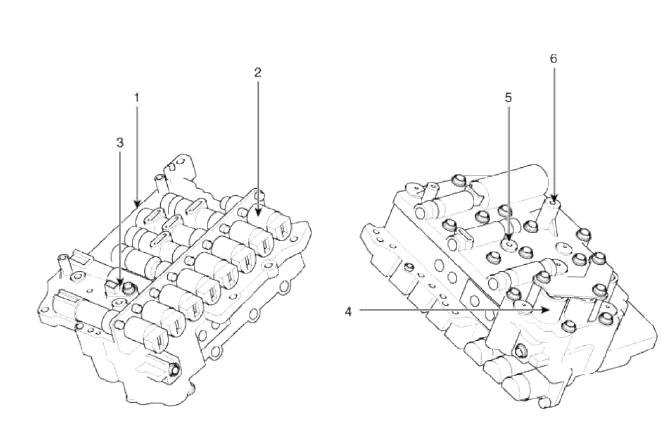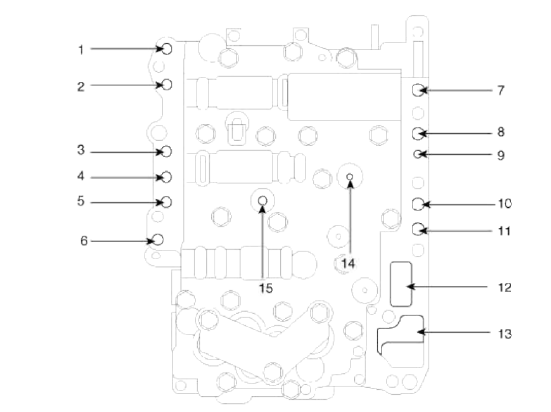Kia Sportage: Valve Body
Description and Operation
Description
The valve body is essential to automatic transaxle control and consists of various valves used to control the oil feed from the oil pump. Specifically, these valves consist of pressure regulator valves, oil redirection valves, shift valves, and manual valves. The body also features electronic solenoid valves that ensure smooth gear changes.

Components and Components Location
Components Location

- PCV adjust screw
- Solenoid valve
- Oil temperature sensor
- Accumulator
- Low & reverse brake (LR/B) pressure flow hole
- Under drive brake (UD/B) pressure flow hole
Valve Body Flow

- To cooler
- From cooler
- Lubrication (rear)
- Overdrive pressure
- Reducing pressure (red2)
- Reducing pressure (red1)
- From damper pressure
- To damper pressure
- Lubrication (front)
- 35R clutch pressure
- 26 brake pressure
- From oil pump
- To oil pump
- Underdrive pressure
- Low & reverse pressure
Repair procedures
Removal
1. Remove the battery and the battery trау. (Refer to "Charging system" in EE group.)
2. Remove the under cover (A).
Tightening torque: 19.6 ~ 24.5 N.m (2.0 ~ 2.5 kgf.m, 14.5 ~ 18.1 lb-ft)

3. Replace new gasket and the plug after draining the automatic transaxle fluid by removing the drain plug. (Refer to "Hydraulic system (Fluid)" in this group)
4. Remove the valve body cover (A) and eyebolt (B).
Tightening torque:
(A) 13.8 ~ 14.7 N.m (1.3 ~ 1.5 kgf.m, 9.4 ~ 10.8 lb-ft)
(B) 34.3 ~ 44.1 N.m (3.5 ~ 4.5 kgf.m, 25.3 ~ 32.6 lb-ft)
CAUTION
Always replace the gasket of the eyebolt use new one whenever loosening eyebolt.

5. Remove the plate and the detent spring (A) after removing the bolt.
Tightening torque: 24.5 ~ 35.3 N.m (2.5 ~ 3.6 kgf.m, 18.1 ~ 26.0 lb-ft)

6. Remove the bolt (3ea) after disconnecting the solenoid valve (B) connector and the oil temperature sensor connector (A).
Tightening torque: 9.8 ~ 11.8 N.m (1.0 ~ 1.2 kgf.m, 7.2 ~ 8.7 lb-ft)

7. Remove the valve body assembly (A).
Tightening torque: 9.8 ~ 11.8 N.m (1.0 ~ 1.2 kgf.m, 7.2 ~ 8.7 lb-ft)

Installation
1. Installation is the reverse of removal.
CAUTION
After replacement or reinstallation procedure of the valve body assembly, must perform procedures below.
NOTE
- Continue to apply liquid gasket at application points at the valve body cover with Ø2.5mm (0.0984in.) thickness.
Liquid gasket Part name : Threebond 1281B or LOCTITE FMD-546
- Adding automatic transaxle fluid. (Refer to "Hydraulic system (Fluid)" in this group)
- Perform TCM learning after replacing the valve body to prevent slow transaxle response, jerky acceleration and jerky startup. (Refer to "Automatic transaxle control system (Repair procedures)" in this group)
READ NEXT:
 Description and Operation, Components and Components Location | Flow Diagram
Description and Operation, Components and Components Location | Flow Diagram
Description and Operation
Description
The 6-spd automatic transaxle consists of an overdrive clutch (OD/C), a one-way clutch (OWC), a lower and reverse brake (LR/B), an underdrive brake (UD/B
SEE MORE:
 Windshield Glass
Windshield Glass
Components and Components Location
Components
Windshield side
molding
Windshield glass
Repair procedures
Replacement
Removal
CAUTION
Put on gloves to protect your hands.
Use seat covers to avoid damaging any surfaces
1. Remove the following items
Front pilla
 Key positions
Key positions
Your vehicle is equipped with four different
ignition positions.
Illuminated ignition switch
Whenever a front door is opened, the
ignition switch will illuminate for your
convenience, provided the ignition
switch is not in the ON position.
The light will go off immediately when
the ignit
Content
- Home
- Kia Sportage - Fifth generation (NQ5) - (2022-2025) - Owner's Manual
- Kia Sportage - Second generation (JEKM) (2005-2015) - Body Workshop Manual
- Kia Sportage Third generation (SL) - (2011-2016) - Service and Repair Manual
- Sitemap
- Top articles